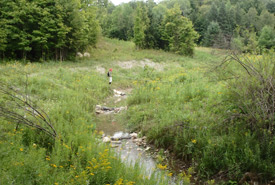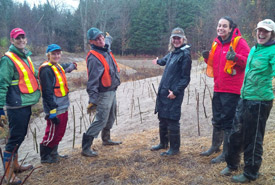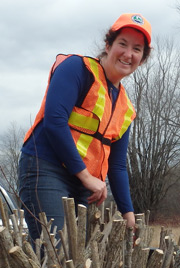How to set a river free

Just add water. Newly opened natural bypass channel! (Photo by NCC)
Perseverance is stubbornness with a purpose. It’s what river lovers need to remove a dam, and set a river free. Luckily for a beautiful trout stream that feeds into the Noisy River near Creemore, Ontario, the Nature Conservancy Canada (NCC) has it in spades.
The Mingay Pond is nestled in NCC’s 200-acre (80-hectare) Creemore Nature Preserve. Full of frogs, turtles and herons, the pond looks quite scenic. However, under its calm surface lurks a secret dark side. The trouble with on-stream ponds (ponds connected to the natural stream course) is that they can have significant negative impacts that can often be present even several kilometres downstream.
In this case, the earthen dam holding back the stream to create the pond was blocking the passage of trout and other fish to their spawning, nursery and summer refuges. Decades of accumulation of sediment and nutrients in the pond was causing toxic algal blooms and overgrowth of vegetation.
The heat is on
More insidious though was the warming of this still body of water under the summer sun. Like a solar panel, the pond’s wide surface absorbs sunlightl; thus warming the water. Amazingly, this small pond heats the water entering from the natural stream by about six degrees Celsius!
Warm water holds much less oxygen. Coupled with the decomposing vegetation and algal blooms, dissolved oxygen decreases further. This warm, low-oxygen water flows downstream.
Water over 24 degrees Celsius, such as that leaving the Mingay pond, holds so little oxygen it threatens cold-water dependent fish like trout and sculpin with suffocation. Even sensitive aquatic insects aren’t immune, putting the foundation of the aquatic food web at risk.
Kristyn Ferguson, program director, Georgian Bay–Huronia at NCC, contacted stewardship staff at the Nottawasaga Valley Conservation Authority (NVCA) in the spring of 2013 to the see what could be done and to inquire about accessing grants to support this work.
"The dam and outflow structure were built over 50 years ago and were starting to become structurally unsound," notes Kristyn. "We hoped that taking the pond offline would reduce the pressure on these structures and allow us to breathe a little easier, knowing we are not putting the entire downstream aquatic system at risk of sedimentation, thermal pollution, contamination or water damage if those structures failed."
"Every site is different," explains Shannon Stephens, Healthy Waters coordinator with the NVCA.
"Solving the issues around this on-stream pond had its challenges. After weighing options, a natural bypass channel where the pond remains but is no longer linked to the cold-water stream, was most desirable. This allowed us to obtain both a trout stream and still retain the offline pond as a rich wetland feature on the site."
Constraints and solutions
Site constraints such as high slopes, erosion and limited space for a bypass channel made design and careful implementation important. The first phase was to come up with a concept, then hire a consultant to survey the site and create engineering plans. Pre-consultation with the NVCA and the Ministry of Natural Resources and Forestry helped determine what permits were required and helped streamline the approval process. Finding funding for implementation is important, as these projects can be expensive. However these types of projects return economic benefits to landowners by dramatically reducing pond sedimentation and costly clean-ups.

Proud volunteers show off their dogwood, alder and willow live stakes along the new channel. “Planted” in the fall with a dead-blow mallet, these will sprout and grow in the spring. (Photo by Nottawasaga Valley Conservation Authority)
This particular project was made possible through the generous support of the NVCA’s Healthy Waters Program, the Department of Fisheries and Oceans Recreational Fisheries Conservation Partnerships Program, the Lake Simcoe–Georgian Bay Clean Up Fund Community Stewardship Program, Environment Canada’s EcoAction program and various NCC donors.
Construction finally began in 2014. The bypass channel was constructed "in the dry," meaning that water from the original stream course was not immediately connected through the new channel. This allowed time for seeding grasses and wildflowers and planting shrubs along the new channel for erosion control by project partners and volunteers. By late summer 2015, the soil plug connecting the new channel to the upstream river was removed and a new trout stream was christened.
"The Creemore stream connection has been one of my favourite restoration projects. I was amazed at how natural the new channel looked after less than a year!" notes Laura Robson, acting coordinator, conservation biology for NCC in Georgian Bay–Huronia. "We had the opportunity to engage volunteers in water quality monitoring and shrub plantings, and everyone shared in the excitement of restoring the stream to healthy, natural and beautiful system."
A river is set free
The Mingay Pond was dammed a long time ago. These days we are aware of the issues dams can create, and streams can no longer be dammed to form on-stream ponds. But with more than 1,200 artificial dams fragmenting streams in the Nottawasaga watershed, there’s much work left to do. To help landowners interested in removing their on-stream ponds, NVCA’s Healthy Water’s program offers grants and technical support. Eligible projects include natural bypass channels, fish-ways, bottom-draws to keep downstream water cooler and even retiring the pond.
Contact NVCA’s Shannon Stephens if you are interested in finding out more (705-424-1479 Ext. 239 or sstephens@nvca.on.ca).
This article was first published on the NVCA website.


